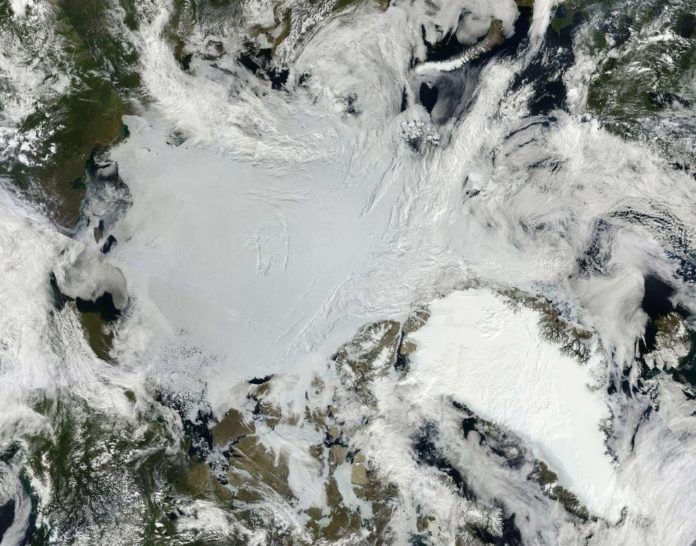NASA has recently selected a couple of novel and creative research proposals to evolve small, space-based instrument to answer primordial queries concern to our home planet and its environment.
Predominantly asked primordial queries are why is the Arctic warming faster than the rest of the planet? Does mineral dust warm or cool the atmosphere?
First proposal chiefly investigated by Tristan L’Ecuyer of the University of Wisconsin, Madison, the Polar Radiant Energy in the Far Infrared Experiment (PREFIRE) which will fly a match of small CubeSat satellites to probe a little-studied portion of the radiant energy released by Earth to give indications about Arctic warming, sea ice loss, and ice-sheet melting.
Second research let by Robert Green of NASA’s Jet Propulsion Laboratory (JPL) in Pasadena, California, that is the Earth Surface Mineral Dust Source Investigation (EMIT) will utilize a sensor mounted to the outside of the International Space Station to ascertain the mineral incorporation of natural sources that produce dust aerosols around the globe.
Post studying in detail which minerals make up the dust, EMIT will assist to respond the essential question of whether this type of aerosol warms or cools the atmosphere.
These two instruments were competitively selected from 14 proposals contemplated under NASA’s fourth Earth Venture Instrument opportunity. Earth Venture investigations are small, targeted science investigations that complement NASA’s larger missions.
The National Research Council recommended in 2007 that NASA undertake this type of regularly solicited, science-based, quick-turnaround project. The council’s recently released decadal survey recommended the immutability of the program.
Michael Freilich, director of the Earth Science Division at NASA Headquarters in Washington said, “PREFIRE and EMIT make innovative use of technologies first developed by NASA for planetary missions to address important, longstanding questions about Earth.”
The Arctic assist to continue Earth’s overall temperature by radiating back into space much of the excess energy from the Sun that is engrossed at lower latitudes. Operating satellite instruments do not detect all of the wavelengths of this energy radiating from our planet.
PREFIRE will fill in the current data gap at far-infrared wavelengths, gathering information that will assist scientists to diagnose the impact of this outgoing radiation on the Arctic region’s energy balance.
Further, it will fly miniaturized thermal infrared spectrometers on two CubeSat satellites, each about the size of a loaf of bread. The sensors are based on technology previously flown on the Mars Climate Sounder, an instrument on NASA’s Mars Reconnaissance Orbiter. The CubeSats will orbit Earth’s poles to gauge far-infrared emissions and how they change throughout the day and over seasons. The observations will permit scientists to assess how changes in thermal infrared emissions at the top of Earth’s atmosphere are associated to changes in cloud cover and surface conditions below, such as the amount of sea ice and meltwater on the surface of the ice.
The assemblage of airborne dust particles is largely unknown, but it is a critical factor in ascertaining whether mineral-based dust has a cooling or warming effect on the atmosphere.
Scientists do not currently have a global inventory of the natural mineral sources of dust, and as a result, the global impacts of dust on whether, atmospheric circulation, and other aspects of Earth’s environment are not well established.
EMIT’s hyperspectral instrument will gauge the distinct wavelengths of light emitted by minerals on the surface of deserts and other dust sources to ascertain their assemblage. The EMIT sensor is based in part on NASA’s Moon Mineralogy Mapper instrument aboard the Indian Space Research Organization’s Chandrayaan-1 spacecraft.
The EMIT team brings together comprehensive expertise that covers mineral measurements, soil science, remote-sensing of surface properties, and Earth system modeling. The project’s modeling component will use the data collected to advance our understanding of the role of atmospheric dust in Earth’s climate and better predict how it can be expected to change in the future.
In addition to this, Earth Venture missions provide an innovative approach to address Earth science research with regular windows of opportunity to accommodate novel scientific priorities. The missions are managed by NASA’s Earth System Science Pathfinder program, located at NASA’s Langley Research Center in Hampton, Virginia, for the agency’s Science Mission Directorate.
The first Earth Venture Instruments headed to space are preparing for launch within the next year. The Global Ecosystem Dynamics Investigation (GEDI) and the ECOsystem Spaceborne Thermal Radiometer Experiment on Space Station (ECOSTRESS) will gauge the sharing, canopy heights, and changes in global vegetation from the space station, receiving insights into how forests and ecosystems are impacted by changes in water availability and other environmental and human factors.
The PREFIRE team brings together expertise in remote sensing, Earth system modeling, and Arctic Ice.
